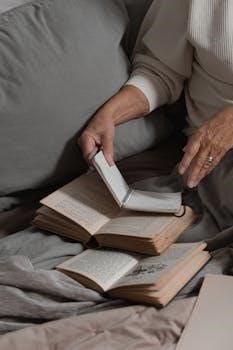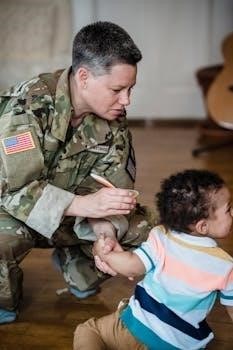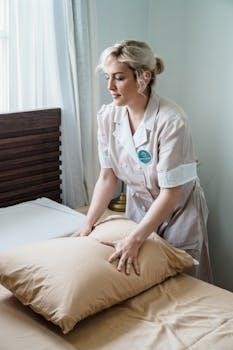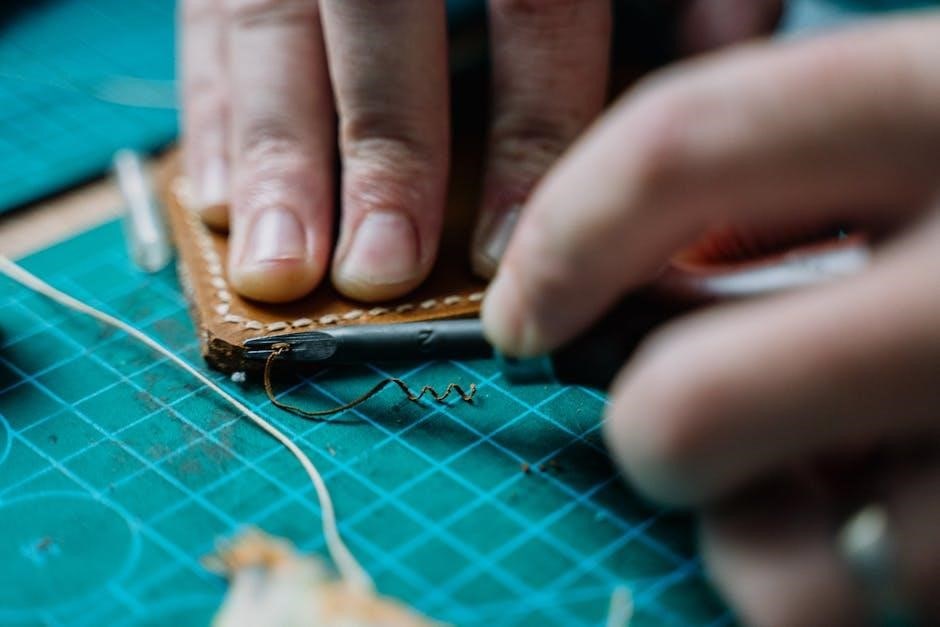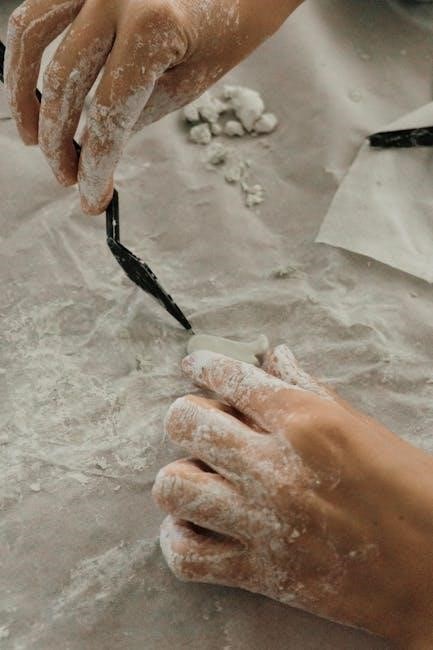Exercises for Bed-Bound Elderly⁚ An Overview
This section introduces the importance of physical activity for elderly individuals confined to bed. It will outline a range of exercises designed to improve flexibility, strength, and overall well-being while minimizing risk and promoting comfort.

Benefits of Bed Exercises for the Elderly
Bed exercises offer numerous advantages for elderly individuals with limited mobility. They combat muscle weakness and deconditioning resulting from prolonged inactivity. Regular exercise improves blood circulation, reducing the risk of blood clots and pressure sores. Maintaining muscle strength helps with mobility progression and independence, even within the confines of a bed.
These exercises also enhance joint flexibility, preventing stiffness and contractures. Furthermore, they contribute to improved respiratory function and overall cardiovascular health. Beyond the physical benefits, bed exercises positively impact mental well-being. Engaging in physical activity can reduce feelings of isolation and depression, boosting mood and self-esteem. The sense of accomplishment from completing exercises can empower individuals and promote a more positive outlook.
Moreover, these exercises can improve sleep quality and reduce fatigue. Consistent movement helps regulate the body’s natural sleep-wake cycle. Remember to consult with a healthcare professional to personalize exercise routines and ensure safety. By addressing physical limitations and promoting movement, bed exercises enhance the overall quality of life.
Safety Precautions Before Starting Bed Exercises
Prioritizing safety is paramount when initiating bed exercises for elderly individuals. Always consult with a healthcare professional, such as a doctor or physical therapist, before starting any new exercise routine. They can assess the individual’s specific health conditions and limitations, tailoring the exercises accordingly. Ensure a clear understanding of any post-operative restrictions.
Begin slowly and gently, monitoring the individual’s response closely. Watch for any signs of pain, discomfort, or shortness of breath. If any of these occur, stop the exercise immediately and consult with a healthcare professional. The exercise environment should be safe and comfortable. Ensure the bed is stable and at a comfortable height for both the individual and the caregiver. Remove any obstacles that could cause tripping or falls.
Provide adequate support and assistance during the exercises, especially if the individual has balance or coordination issues. Use proper body mechanics to prevent injury to both the individual and the caregiver. Encourage deep breathing throughout the exercises. Stay hydrated. Remember to modify exercises. Personalized care is essential.
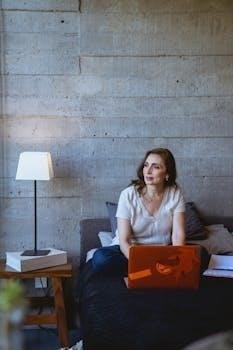
Types of Bed Exercises⁚ Range of Motion
Range of motion exercises are crucial for maintaining joint flexibility and preventing stiffness in bed-bound elderly individuals. These gentle movements help circulate synovial fluid, nourishing cartilage and reducing the risk of contractures. They promote overall comfort and mobility.
Ankle Pumps
Ankle pumps are a simple yet effective range of motion exercise that can be easily performed by bed-bound elderly individuals. This exercise primarily focuses on improving circulation in the lower legs and feet, which is essential for preventing blood clots and reducing swelling.
How to perform ankle pumps⁚
- Lie on your back with your legs extended;
- Point your toes away from your body as far as comfortably possible.
- Then, pull your toes up towards your shin, flexing your ankle.
- Repeat this movement rhythmically, alternating between pointing and flexing your toes.
Aim for 10-15 repetitions of ankle pumps several times a day. Encourage slow and controlled movements to maximize the benefits. This exercise can be easily incorporated into a daily routine and adapted based on the individual’s comfort level. Remember to consult with a healthcare professional before starting any new exercise program, especially if there are underlying health conditions.
Ankle pumps are a valuable tool in maintaining lower limb health and promoting circulation for bed-bound elderly individuals.
Heel Slides
Heel slides are a gentle exercise designed to improve knee and hip flexibility for bed-bound elderly individuals. This exercise helps maintain joint mobility and prevent stiffness, contributing to better overall comfort and range of motion. It’s a simple yet effective way to keep the lower body active while minimizing strain.
How to perform heel slides⁚
- Lie on your back with your legs extended.
- Bend one knee by sliding your heel towards your buttocks, keeping your heel in contact with the bed.
- Slowly straighten your leg back to the starting position, sliding your heel along the bed.
- Repeat the movement with the other leg.
Aim for 10-15 repetitions on each leg, several times a day. Ensure the movements are slow and controlled, avoiding any sudden jerks. If any pain or discomfort arises, stop the exercise and consult with a healthcare professional. Heel slides are a valuable addition to a bed-bound exercise routine, promoting joint health and mobility in a safe and manageable way. Regular practice can help maintain a better quality of life.
Knee Bends
Knee bends are a beneficial exercise for bed-bound elderly individuals, designed to improve knee joint mobility and circulation in the lower limbs. This simple movement can help prevent stiffness and discomfort, promoting a greater sense of well-being and easing daily tasks that may require some leg movement.
How to perform knee bends⁚
- Lie on your back with both legs extended.
- Gently bend one knee, bringing your heel towards your buttocks as far as is comfortable.
- Hold the bent position for a few seconds, focusing on controlled movement.
- Slowly straighten your leg back to the starting position.
- Repeat the process with the other leg.
Perform 10-15 repetitions on each leg, multiple times throughout the day. It’s crucial to listen to your body and avoid pushing beyond your comfort level. If you experience any pain, stop immediately and consult a healthcare professional. Consistent practice of knee bends can contribute to improved knee function and overall comfort for bed-bound individuals, enhancing their quality of life and promoting better circulation.
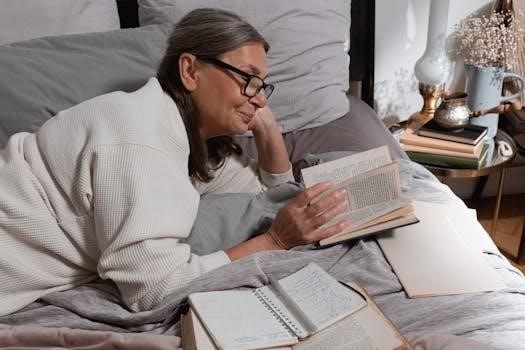
Types of Bed Exercises⁚ Strengthening Exercises
This section focuses on exercises aimed at building and maintaining muscle strength for bed-bound elderly individuals. These exercises help combat muscle weakness and promote overall physical well-being, within limitations.
Isometric Exercises
Isometric exercises are a fantastic way for bed-bound elderly individuals to maintain and even build strength without requiring movement of the joints. These exercises involve contracting muscles without changing their length, making them ideal for those with limited mobility or pain. They improve muscle tone, circulation, and can help prevent muscle atrophy that often accompanies prolonged bed rest.
One common isometric exercise is a “gluteal squeeze,” where the person squeezes their buttock muscles together and holds for a few seconds, then relaxes. Another is pressing the palms of the hands together tightly. An individual can also perform a quad set by tightening the thigh muscle while lying in bed, holding it for a few seconds, and releasing.
These exercises can be easily modified to suit individual capabilities and comfort levels. It’s crucial to start slowly and gradually increase the duration and intensity of the contractions as strength improves. Ensure proper breathing during each exercise, avoiding holding the breath, and consult with a healthcare professional or physical therapist for guidance and modifications.
Arm Raises
Arm raises are simple yet effective strengthening exercises suitable for bed-bound elderly individuals. These exercises help maintain upper body strength, improve circulation, and prevent stiffness in the shoulders and arms. They can be easily modified based on individual strength levels and range of motion, making them accessible to many.
To perform a basic arm raise, the individual starts by lying on their back or sitting up in bed, depending on their comfort and ability. Slowly lift one arm towards the ceiling, keeping the elbow straight but not locked. Raise the arm as high as comfortable, then slowly lower it back down. Repeat this movement with the other arm. Small weights, like soup cans, can be added for a challenge.
Variations include raising the arms to the side or performing small circular motions with the arms. It is essential to focus on controlled movements and avoid straining. If any pain or discomfort arises, the exercise should be stopped or modified. A physical therapist can provide guidance on proper form and modifications for specific needs.
Leg Raises
Leg raises are strengthening exercises that target the muscles in the legs and core, beneficial for bed-bound elderly individuals. These exercises can help improve lower body strength, circulation, and joint mobility, all of which are crucial for maintaining overall well-being and facilitating potential future mobility.
To perform a leg raise, the individual lies on their back with one leg straight and the other bent at the knee for support. The straight leg is then slowly lifted a few inches off the bed, keeping the knee straight but not locked. Hold this position for a few seconds, then slowly lower the leg back down. Repeat with the other leg. Small weights, like ankle weights, can be added for a challenge as strength improves.
Variations include side leg raises, where the leg is lifted out to the side, and bent leg raises, where the knee is bent as the leg is lifted. It’s important to maintain proper form and avoid arching the back during the exercise. If any pain or discomfort occurs, the exercise should be stopped or modified. Consulting with a physical therapist can help ensure proper technique and address any individual needs.

Importance of Personalized Care and Professional Consultation
When implementing exercise programs for bed-bound elderly individuals, personalized care and professional consultation are paramount. Each person has unique health needs, physical limitations, and medical conditions that must be carefully considered to ensure safety and maximize benefits. A one-size-fits-all approach is not suitable, as it can lead to injury or exacerbate existing health issues.
Professional consultation with a doctor or physical therapist is essential to assess the individual’s overall health status, identify any contraindications to exercise, and develop a tailored exercise plan. This plan should take into account the individual’s current level of mobility, strength, and cognitive function. It’s crucial to set realistic goals and gradually increase the intensity and duration of exercises as tolerated.
Personalized care also involves considering the individual’s preferences, comfort levels, and emotional well-being. Creating a supportive and encouraging environment can help motivate them to participate in the exercises and adhere to the program. Regular monitoring and adjustments are necessary to adapt to changing needs and ensure continued progress. Addressing physical limitations and promoting movement enhances the overall quality of life.
Resources⁚ Printable Bed Exercise PDFs
To further support caregivers and healthcare professionals in implementing bed exercise programs for the elderly, a collection of printable PDF resources is invaluable. These PDFs provide readily accessible visual guides, step-by-step instructions, and clear illustrations of various exercises suitable for bed-bound individuals. They serve as a convenient reference for performing the exercises correctly and safely.
These resources often include exercises targeting range of motion, strengthening, and flexibility, tailored to different levels of ability. They may also feature variations and modifications to accommodate specific needs and limitations. The printable format allows caregivers to easily access and utilize the information at the bedside, ensuring consistent and effective implementation of the exercise program.
Furthermore, some PDFs may include tracking sheets or logs to monitor progress and adherence. It is important to consult a healthcare professional before starting any new exercise routine. These resources are intended to supplement, not replace, professional guidance and personalized care. Carepatrons offers printable exercises for bed-bound elderly individuals, emphasizing personalized care and aiming to enhance their overall quality of life by addressing physical limitations and promoting movement.
